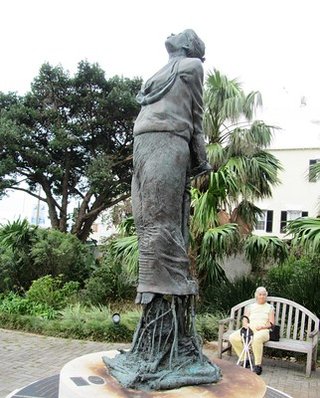Sarah Sally Basset
This is a true story of Sarah Bassett (popularly known as Sally Bassett) who was a slave in Bermuda during the 18th century. Bermuda was then a British colonial island. The ghastly act on the day of June 21, 1730 when she was burned alive at Crow Lane near the Hamilton Harbor remains as a poignant chapter of slave history to the Bermudians and the world, and serves as a burning example of what slavery meant to the slave society in Bermuda in those years.
Sally was a mulatto woman - having a mixed white and black ancestry. But she was a slave and brought up several children of her own and even grandchildren. In 1730 she was owned by Foster (a white mariner) in Bermuda who also owned her grand daughter Beck as well as another house slave Nancey. This was when Mr. and Mrs. Foster along with the house slave Nancey fell seriously ill. However Beck and Sally remained unaffected by such illness in the house.
During interrogation, Beck revealed that her Grandma Sally asked her to mix poison in the food. In fact such possibility was pointed out by the other house slave Nancey. The investigating team found out poison in the kitchen cupboard. Sally Bassett was judged guilty and sentenced to death and to be burnt alive. This is what the final sentence said:
"To be conveyed to the place of execution where a pile of wood is to be made and provided and you are thereto be fastened to a sufficient stake and there be burnt with fire until your body be dead."
Photo: flickr (Public Domain)
On the day of her execution, large crowd gathered to watch the grisly act. It is said that when Sally was taken to the execution, looking at the large crowd following her, she said "There'll be no fun 'til I get there".
Many say that after Sally's death, plenty of Bermuda's indigenous purple flowers known as Bermudiana were found in her ashes. This flower has been since associated with her name. Also, the day of her execution was a very hot day. So a hot day in the island has become known as 'Sally Bassett Day'.
On the day of her death, value of Sally was considered useless because of her age. A 10-ft tall statue of Sally Bassett was built in 2008 in the
grounds of Cabinet Office in Hamilton City. The statue depicts Sally standing on a stake with her hands tied behind. This was the first statue and memorial created for a slave of Bermuda. Tourists can see the statue by visiting the Cabinet office premises.
A note about Sally Basset story
During investigation it was figured out that white toad was used and mixed with food for poisoning the Foster family. The skin of white toad is poisonous and such toads are usually found in the swamps of Africa. So it is anticipated that one of the seagoing black slaves would have cooperated with Sally and brought the toad skin from Africa.
The burning in public was meant for teaching a lesson to the black slave community in Bermuda about the consequence of such acts of conspiracy against the masters. However the news of the execution spread in the Caribbean and North American colonies. The black mariners were instrumental in spreading the news. And that in fact served as an inspiration to the slave communities there and several other rebelling slave women took recourse to toad poisoning of their masters.
|
 By Raj Bhattacharya By Raj Bhattacharya
Raj, a seasoned travel writer and Bermuda destination expert, has extensive global travel experience. This website reflects his profound insights, garnered over nearly two decades of dedicated findings and research on the island. Raj has assisted countless Bermuda-bound visitors by providing direct, personalized responses to their queries and imparting his wealth of knowledge through this platform. This site serves as an indispensable guide for those seeking informed and reliable insights into Bermuda's treasures.
|
Related Articles
|
Visitors' Reviews and Comments
Share your experience.
|

 By Raj Bhattacharya
By Raj Bhattacharya